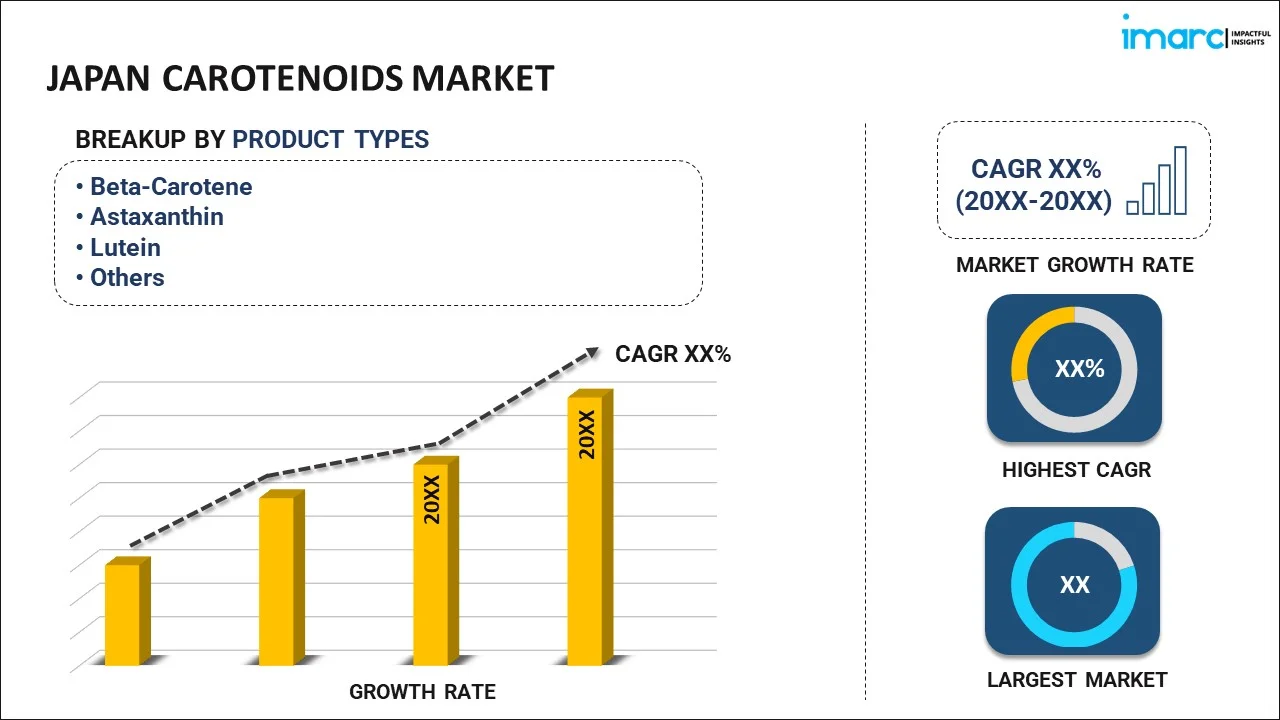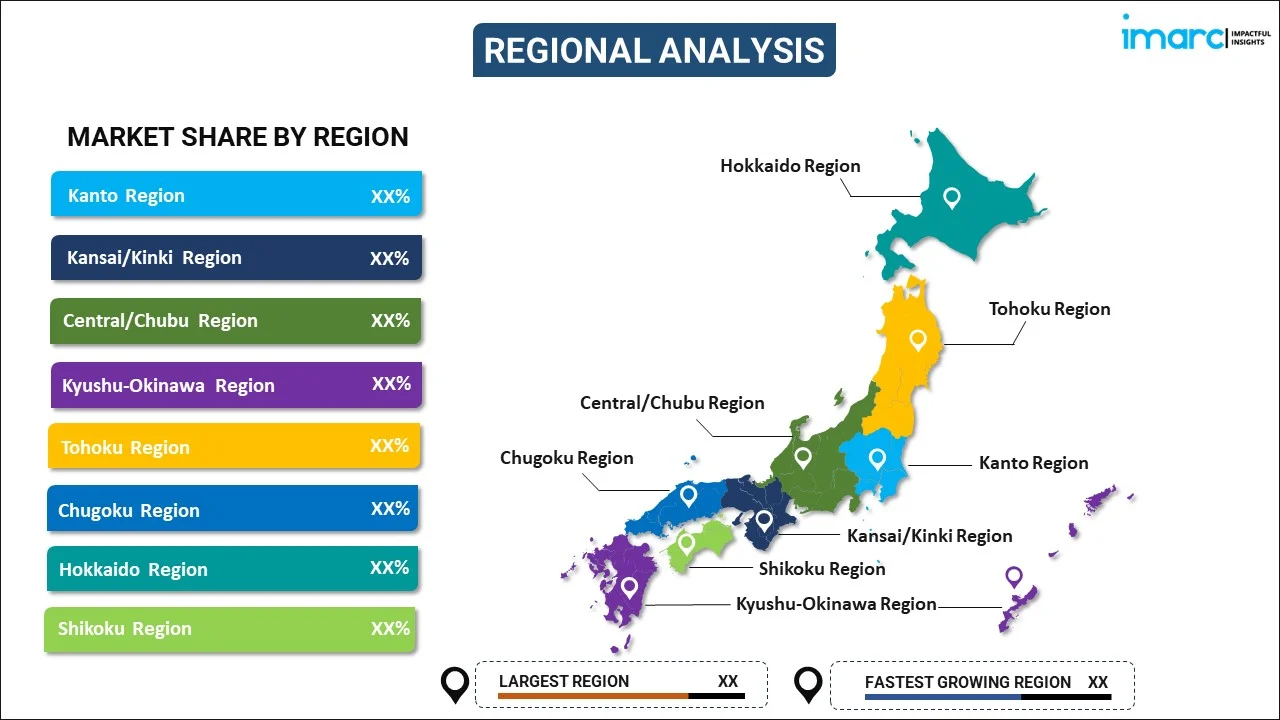
Japan Carotenoids Market Report by Product Type (Beta-Carotene, Astaxanthin, Lutein, Lycopene, Zeaxanthin, Canthaxanthin, and Others), Source (Synthetic, Natural), Formulation (Oil Suspension, Powder, Emulsion, and Others), Application (Animal Feed, Dietary Supplements, Food and Beverages, Cosmetics, and Others), and Region 2025-2033
Market Overview:
Japan carotenoids market size reached USD 77.9 Million in 2024. Looking forward, IMARC Group expects the market to reach USD 124.3 Million by 2033, exhibiting a growth rate (CAGR) of 4.94% during 2025-2033. Numerous advancements to extract these compounds, as they act as a valuable component in various sectors, including agriculture, healthcare, personal care, etc., are primarily driving the market growth.
|
Report Attribute
|
Key Statistics
|
|---|---|
|
Base Year
|
2024
|
|
Forecast Years
|
2025-2033
|
|
Historical Years
|
2019-2024
|
| Market Size in 2024 | USD 77.9 Million |
| Market Forecast in 2033 | USD 124.3 Million |
| Market Growth Rate 2025-2033 | 4.94% |
Carotenoids are a diverse group of organic pigments responsible for the vibrant red, yellow, and orange hues seen in various fruits and vegetables. These compounds fall under the category of phytonutrients, crucial for the well-being of plants, and they serve as valuable sources of both vitamin A and antioxidants. Carotenoids can be produced artificially, and they naturally occur in a wide array of organisms, including plants, algae, bacteria, and fungi. There are numerous natural sources of carotenoids, with examples such as papaya, pineapple, pumpkin, apricot, carrot, orange, and corn. Among the carotenoids frequently utilized, both alpha and beta carotene, beta-cryptoxanthin, lutein, zeaxanthin, and lycopene are commonly added as colorants in various products, including food, cosmetics, and animal feed. In the realm of human health, carotenoids play a pivotal role in cancer treatment, vision improvement, and the support of physical growth and development.
Japan Carotenoids Market Trends:
The Japan carotenoids market is experiencing significant growth, primarily driven by several key factors. Firstly, the increasing prevalence of cancer and age-related ophthalmic disorders has emerged as a prominent driver, emphasizing the role of carotenoids in healthcare. These compounds are recognized for their potential in cancer prevention and in addressing eye health issues, which is positively influencing the regional market. Moreover, the widespread incorporation of carotenoids into dietary supplements and various pharmaceutical products further contributes to market expansion. As health consciousness continues to rise, and with an aging population, consumers are increasingly turning to preventive healthcare solutions that harness the antioxidant properties of carotenoids to combat chronic diseases, cellular damage, and the detrimental effects of aging. Carotenoids also play a crucial role in animal nutrition, enhancing fertility and overall immunity in livestock and feed products. This application, combined with ongoing technological advancements in extraction methods, positions carotenoids as a valuable component in the agriculture and animal husbandry sectors. Additionally, the growing demand for natural coloring agents in various industries, including food and cosmetics, is anticipated to fuel the regional market over the forecasted period.
Japan Carotenoids Market Segmentation:
IMARC Group provides an analysis of the key trends in each segment of the market, along with forecasts at the country level for 2025-2033. Our report has categorized the market based on product type, source, formulation, and application.
Product Type Insights:

- Beta-Carotene
- Astaxanthin
- Lutein
- Lycopene
- Zeaxanthin
- Canthaxanthin
- Others
The report has provided a detailed breakup and analysis of the market based on the product type. This includes beta-carotene, astaxanthin, lutein, lycopene, zeaxanthin, canthaxanthin, and others.
Source Insights:
- Synthetic
- Natural
A detailed breakup and analysis of the market based on the source have also been provided in the report. This includes synthetic and natural.
Formulation Insights:
- Oil Suspension
- Powder
- Emulsion
- Others
The report has provided a detailed breakup and analysis of the market based on the formulation. This includes oil suspension, powder, emulsion, and others.
Application Insights:
- Animal Feed
- Dietary Supplements
- Food and Beverages
- Cosmetics
- Others
A detailed breakup and analysis of the market based on the application have also been provided in the report. This includes animal feed, dietary supplements, food and beverages, cosmetics, and others.
Regional Insights:

- Kanto Region
- Kansai/Kinki Region
- Central/ Chubu Region
- Kyushu-Okinawa Region
- Tohoku Region
- Chugoku Region
- Hokkaido Region
- Shikoku Region
The report has also provided a comprehensive analysis of all the major regional markets, which include Kanto Region, Kansai/Kinki Region, Central/ Chubu Region, Kyushu-Okinawa Region, Tohoku Region, Chugoku Region, Hokkaido Region, and Shikoku Region.
Competitive Landscape:
The market research report has also provided a comprehensive analysis of the competitive landscape. Competitive analysis such as market structure, key player positioning, top winning strategies, competitive dashboard, and company evaluation quadrant has been covered in the report. Also, detailed profiles of all major companies have been provided.
Japan Carotenoids Market Report Coverage:
| Report Features | Details |
|---|---|
| Base Year of the Analysis | 2024 |
| Historical Period | 2019-2024 |
| Forecast Period | 2025-2033 |
| Units | Million USD |
| Scope of the Report | Exploration of Historical Trends and Market Outlook, Industry Catalysts and Challenges, Segment-Wise Historical and Future Market Assessment:
|
| Product Types Covered | Beta-Carotene, Astaxanthin, Lutein, Lycopene, Zeaxanthin, Canthaxanthin, Others |
| Sources Covered | Synthetic, Natural |
| Formulations Covered | Oil Suspension, Powder, Emulsion, Others |
| Applications Covered | Animal Feed, Dietary Supplements, Food and Beverages, Cosmetics, Others |
| Regions Covered | Kanto Region, Kansai/Kinki Region, Central/ Chubu Region, Kyushu-Okinawa Region, Tohoku Region, Chugoku Region, Hokkaido Region, Shikoku Region |
| Customization Scope | 10% Free Customization |
| Post-Sale Analyst Support | 10-12 Weeks |
| Delivery Format | PDF and Excel through Email (We can also provide the editable version of the report in PPT/Word format on special request) |
Key Questions Answered in This Report:
- How has the Japan carotenoids market performed so far and how will it perform in the coming years?
- What has been the impact of COVID-19 on the Japan carotenoids market?
- What is the breakup of the Japan carotenoids market on the basis of product type?
- What is the breakup of the Japan carotenoids market on the basis of source?
- What is the breakup of the Japan carotenoids market on the basis of formulation?
- What is the breakup of the Japan carotenoids market on the basis of application?
- What are the various stages in the value chain of the Japan carotenoids market?
- What are the key driving factors and challenges in the Japan carotenoids?
- What is the structure of the Japan carotenoids market and who are the key players?
- What is the degree of competition in the Japan carotenoids market?
Key Benefits for Stakeholders:
- IMARC’s industry report offers a comprehensive quantitative analysis of various market segments, historical and current market trends, market forecasts, and dynamics of the Japan carotenoids market from 2019-2033.
- The research report provides the latest information on the market drivers, challenges, and opportunities in the Japan carotenoids market.
- Porter's five forces analysis assist stakeholders in assessing the impact of new entrants, competitive rivalry, supplier power, buyer power, and the threat of substitution. It helps stakeholders to analyze the level of competition within the Japan carotenoids industry and its attractiveness.
- Competitive landscape allows stakeholders to understand their competitive environment and provides an insight into the current positions of key players in the market.
Need more help?
- Speak to our experienced analysts for insights on the current market scenarios.
- Include additional segments and countries to customize the report as per your requirement.
- Gain an unparalleled competitive advantage in your domain by understanding how to utilize the report and positively impacting your operations and revenue.
- For further assistance, please connect with our analysts.
 Inquire Before Buying
Inquire Before Buying
 Speak to an Analyst
Speak to an Analyst
 Request Brochure
Request Brochure
 Request Customization
Request Customization




.webp)




.webp)












